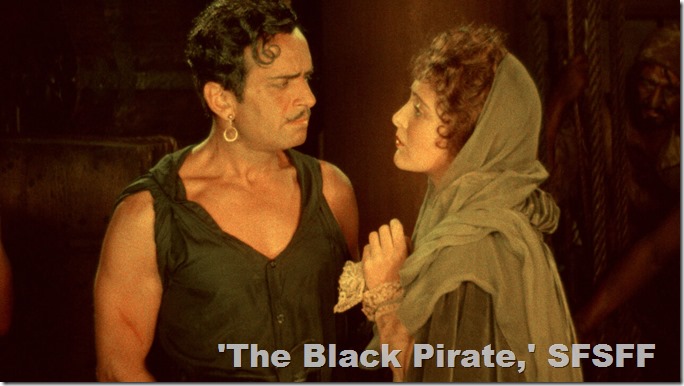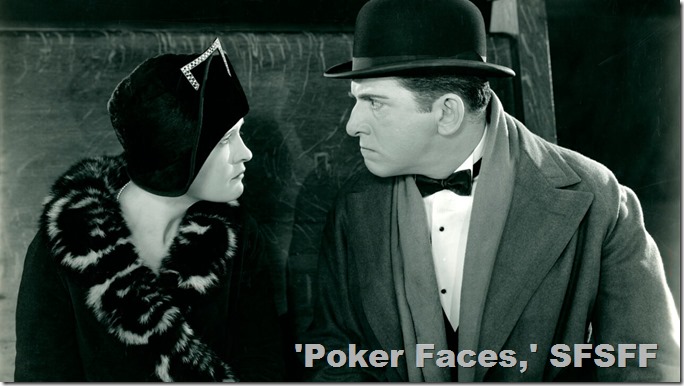
While the recently concluded 27th SFSFF moved from the beautiful vintage Castro Theatre to a new barnlike structure adjacent to the remaining structure from the 1915 Panama Pacific Intl. Exposition, it once again featured diverse programming offering an emotional, humanistic punch. Covering such themes as pirates, alienation and anxiety, damaged individuals, the end of life, and glimpses of the shadow self, movies provided an intimate look to the troubles and problems we still face today. Stylistic flourishes such as silhouettes and shadows capturing the darker side of life, avant-garde touches like dissolves and wipes, and even tight, isolationist framing played up separateness and aloneness.
The Festival kicked off with a beautifully restored two-strip Technicolor print of Douglas Fairbanks’ rousing “The Black Pirate,” a joyous celebration of action and derring do. Featuring great stunts like sliding down giant sails while slicing them in half, navy seal-like soldiers flying ala the “Wizard of Oz” monkeys but through water, and a celebratory climb by Doug via raised hands, the film saw a strong, athletic Fairbanks overcome a rogue band of pirates and save the lovely Billie Dove’s honor. The restored print highlighted the gold and brownish hues intended to represent woodcuts. Donald Sosin provided a lilting score but this film calls for a rousing, Erich Korngold-like composition.

Thursday opened with the always informative “Tales From the Archives” program relaying the background of new restorations or discoveries. Bryony Dixon of the British Film Institute described the restoration of a short series blending humor and travel called “Travelaughs,” featuring a young Michael Powell as actor. Shot in and around Cannes, France, the footage included glorious landscapes and goofy segments of chasing insects and a humorous dream of playing and singing with wood nymphs. In his letters home to his mother, Powell presciently described himself as a future famous director.
A segment described the finding and preserving the only film produced by the Japanese American Film Co. in 1914, an all Japanese-American version similar to “Madame Butterfly.” A lovely young couple pledged to marry since childhood vow once the young man returns from college in America, but his betrothed rescues and nurses a soldier back to health before he returns. Shot possibly around Berkeley as well as Terminal Island, the film includes fine performances by the main couple and nice framing.
David Pierce, formerly of the Library of Congress, presented a short but informative program on the evolution of the Technicolor Motion Picture Corporation and how innovations over four films in the 1920s would set it up as the main color process in American film for decades. Stephen Horne provided evocative scores for each, from a play on pastoral nature to Oriental hints via flute.

Biographer/historian David Stenn recounted the amazing story of how a long lost Clara Bow film turned up in a bankruptcy fire sale of a film distribution site. Shot just a few weeks after her dear mother passed away, a vivacious 17-year-old Bow sparkled in “The Pill Pounder” in the few scenes in which she appeared opposite a over-the-top Charlie Murray playing a put upon pharmacist. Fine slapstick timing, sight gags, cutting, and set ups rendered it funny.
Herbert Brenon’s timely “Dancing Mothers” followed, a look at honestly following your dreams and heart. A flashy but naive Clara flirts with everything around, falling in love with a selfish rogue, whose paramour goes off with her doltish father as they both visit a pirate cafe. Loyal, trusting Joyce, who’s sacrificed her career and her life caring for her family, comes to the conclusion that she is deserving of happiness and consideration from people who supposedly love her. Frank, honest, and modern, Joyce steals the show with her lovely understated performance. Pianist Wayne Barker provided a bouncy beat to the short, and a more restrained, rolling backbeat to the feature.
Pordenone director Jay Weissberg cheekily but pointedly introduced the recently restored Syd Chaplin slapstick comedy, “Oh! What a Nurse!.” Relaying more than 100-year-old reviews praising the integrity, respect, and dignity of various drag performers and their acts, he disparaged current drag show bans by those also despicably banning books. Chaplin gives a hilarious performance in a story of mistaken identity and duplicitous motives, aided by excellent timing, pacing, and reactions. Donald Sosin added a nice playful touch with his uptempo score.
Norma Talmadge gave a luminous performance in Frank Borzage’s emotional “The Lady.” Charming show girl Talmadge falls in love with weaselly blue blood Wallace MacDonald who abandons her in Southern France. Forced to endure traumatic situations working in a flophouse to support herself and baby, Norma finds despair wherever she turns, letting emotions subtly play through her eyes and face. High end production design by William Cameron Menzies, dramatic lighting by Tony Gaudio, and lovely costumes by Clare West add rich detail to the film. Horne’s wistful, bittersweet score provides a subtle backbone for the film.
The evening concluded with the thrilling adventure “The Sea Hawk,” starring a magnetic Milton Sills. Elizabethan aristocrat Sills finds himself sold into slavery at the hands of his wastrel brother, but finds glory and leadership in this big-budget marine epic shot around Catalina Island. Muscular but sensitve Sills steals the show with subtle but powerful acting, overshadowing the over the top Enid Bennett. Mont Alto Motion Picture Orchestra provided a rich score full of majestic marches and evocative dreams.
Allan Dwan’s energetic “East Side, West Side” featured romantic flourishes and deep pride in bustling, booming New York City, highlighted by excellent production work and fine acting. Painterly images of the waterfront and cityscape, dramatic lighting, avant-garde, surreal dissolves/fades, and fine production design complemented George O”Brien’s sympathetic boyish performance and Virginia Valli’s tough, direct love interest. This story was timely as well, featuring a smorgasbord of needed immigrants – snappy Irish lads, protective Eastern European Jews, etc., building a world class city. I had forgotten the strange Titanic subplot thrown in. Wayne Barker’s romantic, upbeat underscoring emphasized a city on the march.
Julien Duvivier’s incredibly moving “Poil de Carotte,” or “Carrot Top,” brought the audience to tears with its depiction of a lonely, anxiety-prone child experiencing alienation and deprivation among his isolating family, particularly his sadistic, camp commandment-style mother. Poetic and humane, sensitive, sweet Carrot Top is loved by nearby friends and family maid, but feels totally left out among his family and at the end of his rope, before a gentle optimism concludes the film. Gorgeous tints and understated filmmaking were complemented by Stephen Horne’s lush, gentle score.

Edward Everett Horton and Laura La Plante virtually stole the festival in their jaunty, energetic movie of mistaken identity, “Poker Faces.” This delicious farce featured pitch perfect timing, reactions, and comic machinations to equal the two leads’ fine performances. Poker faced rube Horton goes to the train station to pick up his boss’s potential new partner and chaos ensues. Horton and La Plante exhibit fine chemistry, expressive faces, and physical dexterity. Guenther Buchwald and Frank Bockius’ jazzy, sensual score energetically propelled the film along.
I skipped the Laurel and Hardy shorts Saturday morning to prepare for the second program, William Wyler’s “Hell’s Heroes,” a heart tugging examination of self-sacrifice and redemption. Three robbers plan to rob a small town Mojave Valley bank, to find everything go wrong. Can they return an orphaned baby to his father while struggling through the hellish heat of the desert? Buchwald’s lean, spare western score perfectly meshed with the understated, moving story, particularly with his singing of “Silent Night” during the town’s Christmas service. Production work is spot on in this, from foreshadowing framing of nooses around the faces of the struggling robbers, a lone Joshua tree in the shape of a cross, lighting, and shot composition. The leads all give fine performances, particularly Fred Kohler, who gets the chance to play a good bad man for once.
Ozu’s lovely “I Was Born… But” followed, a tale of trying to fit in and find your place. After a family moves to a more upscale suburb, two precocious, mischievous brothers juggle trying to form friendships among the local boys while coming to understand their father’s true profession and place in society. Gentle, bittersweet, but filled with comic touches, it introduces themes vital to Ozu’s work. Composition is lovely, emphasizing the isolated nature of modern society with its long train lines, modern new telephone poles, and tiny cramped rooms. Respect, value, and dignity undergird its themes, echoed in Utsav Lal’s lilting, wistful score.
The seductive, powerful “die Strasse” (“the Street”) followed, emphasizing the dark, seductive decadence of the flashy city. A staid homeowner finds himself enraptured by the temptations of the sensual, pulsing city, only to become entrapped in gritty and grim machinations of naked society. Built entirely in a studio, the bustling, Expressionist-style city with its shadowy threats and shallow pleasures captured the growing threats of nationalism and menace after the war. Buchwald and Bockius once again provided an evocative score, emphasizing sensual playfulness and an almost Mack the Knife like killer score. Dramatic effects foreshadowing potential doom like a prostitute’s face overladen with a skull effect and a billboard with giant eyes add suspense and dread.

After skipping the last two programs on Saturday night, I attended the first two programs on Sunday. Cineteca Milano discovered the long lost “The Gorilla,” a holy grail for comedy fans. Alas, it lacks little comedy, a static hodge podge of mystery, slight humor, and old dark house, offering a few chuckles but strangely flat. A giant gorilla is causing havoc around a metropolis, followed by the strange death of a miserly millionaire. Can both mysteries end well? Though a late 1920s film, it features slow pacing reminiscent of the 1910s, which kills energy and comedy. Tully Marshall adds a little of his oily charm, but acting is also flat. However, technical work is particularly outstanding, including moody lighting, a terrific rising crane shot up a spiral staircase similar to that in “Seventh Heaven” which resolves into a dolly shot into a desk, and particularly thrilling shots of a giant gorilla on realistic metropolis-like mattes that foreshadow “King Kong.” Horne and Bockius did what they could to add threatening suspense with their mysterious score.
My last film of the Festival was the always entertaining “The Kid Brother,” one of Harold Lloyd’s gentle, sweet family comedies, allowing the meek Harold to win the girl and save the day with derring do. Shot around Catalina Island like several others, the movie featured fine timing and comic moments along with some strong action sequences, aided by the pastoral lilt of the always delightful Mont Alto Motion Picture Orchestra.
Inventive festival programming highlighted timely issues and subjects confronting society today, highlighted by gorgeous music emphasizing emotional cues. The San Francisco Silent Film Festival provides a rich treat for all the senses in its wonderful presentation of silent films.


Always a joy to read your reviews, Mary.
LikeLike
thank you.
LikeLike
Thanks for the reviews–it was nice to get your take. The new venue is in a beautiful locale, but it seemed like the audience spirit was more subdued this time. I doubt that was entirely because they didn’t allow snacks in the theater, or have a popcorn machine, but I suspect that was part of it!
LikeLike
Audience reaction was definitely more subdued. And food and snacks are always important!
LikeLike